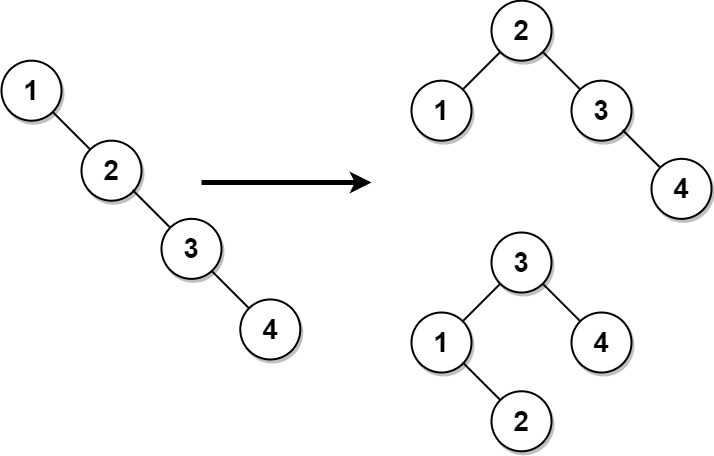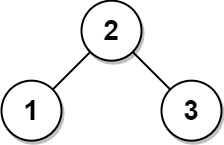- {x}
- Generate a String With Characters That Have Odd Counts
- Number of Times Binary String Is Prefix-Aligned
- Time Needed to Inform All Employees
- Frog Position After T Seconds
- Replace Employee ID With The Unique Identifier
- Find a Corresponding Node of a Binary Tree in a Clone of That Tree
- Lucky Numbers in a Matrix
- Design a Stack With Increment Operation
- Balance a Binary Search Tree
- Maximum Performance of a Team
- Total Sales Amount by Year
- Find the Distance Value Between Two Arrays
- Cinema Seat Allocation
- Sort Integers by The Power Value
- Pizza With 3n Slices
- Create Target Array in the Given Order
- Four Divisors
- Read More...

Balance a Binary Search Tree
Given the root of a binary search tree, return a balanced binary search tree with the same node values. If there is more than one answer, return any of them.
A binary search tree is balanced if the depth of the two subtrees of every node never differs by more than 1.
Example 1:

Input: root = [1,null,2,null,3,null,4,null,null] Output: [2,1,3,null,null,null,4] Explanation: This is not the only correct answer, [3,1,4,null,2] is also correct.
Example 2:

Input: root = [2,1,3] Output: [2,1,3]
Constraints:
- The number of nodes in the tree is in the range
[1, 104]. 1 <= Node.val <= 105
Solution Explanation: Balancing a Binary Search Tree
This problem requires transforming a given Binary Search Tree (BST) into a balanced BST while preserving the original node values. The optimal approach involves these steps:
-
In-order Traversal: Perform an in-order traversal of the input BST. In-order traversal visits nodes in ascending order for a BST. This gives us a sorted array (
nums) containing all the node values. -
Balanced BST Construction: Construct a new balanced BST from the sorted array using a recursive helper function
build(i, j). This function works as follows:- Base Case: If
i > j(empty subarray), returnnull(representing an empty subtree). - Recursive Step: Find the middle element
mid = (i + j) / 2. This middle element becomes the root of the subtree being constructed. Recursively callbuildto create the left subtree (build(i, mid - 1)) using elements fromitomid - 1and the right subtree (build(mid + 1, j)) using elements frommid + 1toj. Finally, construct and return a new tree node with the middle element as the value, and the left and right subtrees.
- Base Case: If
Time Complexity Analysis:
- In-order traversal takes O(n) time, where n is the number of nodes.
- Building the balanced BST also takes O(n) time because each node is visited and processed once during the recursive calls.
- Therefore, the overall time complexity is O(n).
Space Complexity Analysis:
- The in-order traversal uses O(h) space in the worst case (a skewed tree) where h is the height of the tree (can be O(n) for a skewed tree, but O(log n) for a balanced tree).
- The recursive
buildfunction uses O(h) space on the call stack, again potentially O(n) for a skewed input tree, but O(log n) for balanced input. - The
numsarray stores n elements, requiring O(n) space. - Thus, the overall space complexity is O(n).
Code Examples:
The code examples provided in Python, Java, C++, Go, and TypeScript all follow the same algorithm. They differ only in syntax and data structure implementations. All implementations demonstrate the in-order traversal to create the sorted nums array, followed by the recursive build function to construct the balanced BST.
Example (Python):
class Solution:
def balanceBST(self, root: TreeNode) -> TreeNode:
nums = []
def inorder(node):
if node:
inorder(node.left)
nums.append(node.val)
inorder(node.right)
def build(l, r):
if l > r:
return None
mid = (l + r) // 2
node = TreeNode(nums[mid])
node.left = build(l, mid - 1)
node.right = build(mid + 1, r)
return node
inorder(root)
return build(0, len(nums) - 1)
The other languages follow a similar structure, adapting the syntax and data types accordingly. The core algorithm remains consistent across all implementations.